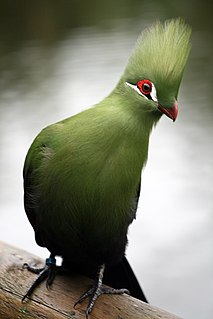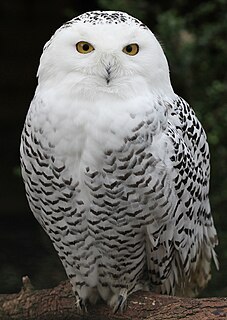
Penguins are a group of aquatic flightless birds. They live almost exclusively in the southern hemisphere: only one species, the Galápagos penguin, is found north of the Equator. Highly adapted for life in the water, penguins have countershaded dark and white plumage and flippers for swimming. Most penguins feed on krill, fish, squid and other forms of sea life which they catch while swimming underwater. They spend roughly half of their lives on land and the other half in the sea.

Birds of prey, also known as raptors, include species of bird that primarily hunt and feed on vertebrates that are large relative to the hunter. Additionally, they have keen eyesight for detecting food at a distance or during flight, strong feet equipped with talons for grasping or killing prey, and powerful, curved beaks for tearing flesh. The term raptor is derived from the Latin word rapio, meaning to seize or take by force. In addition to hunting live prey, many birds, such as fish eagles, vultures, and condors, eat carrion.

The Gruiformes are an order containing a considerable number of living and extinct bird families, with a widespread geographical diversity. Gruiform means "crane-like".

The turacos make up the bird family Musophagidae ( "banana-eaters"), which includes plantain-eaters and go-away-birds. In southern Africa both turacos and go-away-birds are commonly known as loeries. They are semi-zygodactylous: the fourth (outer) toe can be switched back and forth. The second and third toes, which always point forward, are conjoined in some species. Musophagids often have prominent crests and long tails; the turacos are noted for peculiar and unique pigments giving them their bright green and red feathers.

The mousebirds are birds in the order Coliiformes. They are the sister group to the clade Eucavitaves, which includes the Leptosomiformes, Trogoniformes (trogons), Bucerotiformes, Piciformes and Coraciformes. This group is now confined to sub-Saharan Africa, and it is the only bird order confined entirely to that continent, with the possible exception of turacos which are considered by some as the distinct order Musophagiformes, and the cuckoo roller, which is the only member of the order Leptosomiformes. Mousebirds had a wider range in the Paleogene, with a widespread distribution in Europe and North America during the Paleocene.
Polarornis is a genus of prehistoric bird, possibly an anserimorph. It contains a single species Polarornis gregorii, known from incomplete remains of one individual found on Seymour Island, Antarctica, in rocks which are dated to the Late Cretaceous.

The kioea was a endemic Hawaiian bird that became extinct around the mid-19th century.

Palaeotis is a genus of paleognath birds from the middle Eocene epoch of central Europe. One species is known, Palaeotis weigelti. The holotype specimen is a fossil tarsometatarsus and phalanx. Lambrect (1928) described it as an extinct bustard, and gave it its consequent name. After a suggestion by Storrs L. Olson, a review of the type specimen and the referral of several other fossils by Houde and Haubold (1987) concluded that Palaeotis is a palaeognath and assigned it to the same order as ostriches; the Struthioniformes.
Ambiortus is a prehistoric bird genus. The only known species, Ambiortus dementjevi, lived sometime during the Barremian age between 136.4 and 125 million years ago in today's Mongolia. It was discovered by Yevgeny Kurochkin in 1982.
Paleontology or palaeontology is the study of prehistoric life forms on Earth through the examination of plant and animal fossils. This includes the study of body fossils, tracks (ichnites), burrows, cast-off parts, fossilised feces (coprolites), palynomorphs and chemical residues. Because humans have encountered fossils for millennia, paleontology has a long history both before and after becoming formalized as a science. This article records significant discoveries and events related to paleontology that occurred or were published in the year 1992.
Paleontology or palaeontology is the study of prehistoric life forms on Earth through the examination of plant and animal fossils. This includes the study of body fossils, tracks (ichnites), burrows, cast-off parts, fossilised feces (coprolites), palynomorphs and chemical residues. Because humans have encountered fossils for millennia, paleontology has a long history both before and after becoming formalized as a science. This article records significant discoveries and events related to paleontology that occurred or were published in the year 1976.

Neoaves is a clade that consists of all modern birds with the exception of Paleognathae and Galloanserae. Almost 95% of the roughly 10,000 known species of modern birds belong to the Neoaves.

Pelagornis is a widespread genus of prehistoric pseudotooth birds. These were probably rather close relatives of either pelicans and storks, or of waterfowl, and are here placed in the order Odontopterygiformes to account for this uncertainty.

Inkayacu is a genus of extinct penguins. It lived in what is now Peru during the Late Eocene, around 36 million years ago. A nearly complete skeleton was discovered in 2008 and includes fossilized feathers, the first known in penguins. A study of the melanosomes, pigment-containing organelles within the feathers, indicated that they were gray or reddish brown. This differs from modern penguins, which get their dark black-brown feathers from unique melanosomes that are large and ellipsoidal.

Strisores is a clade of birds that includes the living families and orders Caprimulgidae, Nyctibiidae (potoos), Steatornithidae (oilbirds), Podargidae (frogmouths), Apodiformes, as well as the Aegotheliformes (owlet-nightjars) whose distinctness was only recently realized. The Apodiformes and the Aegotheliformes form the Daedalornithes.

Afroaves is a clade of birds, consisting of the kingfishers and kin (Coraciiformes), woodpeckers and kin (Piciformes), hornbills and kin (Bucerotiformes), trogons (Trogoniformes), cuckoo roller (Leptosomiformes), mousebirds (Coliiformes), owls (Strigiformes), raptors (Accipitriformes) and New World vultures (Cathartiformes). The most basal clades are predatory, suggesting the last common ancestor of Afroaves was also a predatory bird.

Telluraves is a recently defined clade of birds defined by their arboreality. Based on most recent genetic studies, the clade unites a variety of bird groups, including the australavians as well as the afroavians. They appear to be the sister group of a newly defined clade centered on Aequornithes.

Coraciimorphae is a clade of birds that contains the order Coliiformes (mousebirds) and the clade Cavitaves. The name however was coined in the 1990s by Sibley and Ahlquist based on their DNA-DNA hybridization studies conducted in the late 1970s and throughout the 1980s. However their Coraciimorphae only contains Trogoniformes and Coraciiformes.

Asteriornis is an extinct genus of bird from the Late Cretaceous of Belgium which is known from a single species, Asteriornis maastrichtensis. It was closely related to birds of the extant superorder Galloanserae such as chickens and ducks. Members of the genus were small, long-legged birds that lived near the coastline and co-existed with more "primitive" types of birds such as Ichthyornis. Asteriornis is one of the oldest-known birds irrefutably belonging to the group Neornithes, which encompasses all modern birds. It possesses characteristics of both galliformes and anseriformes, indicating its position as a close relative of the last common ancestor for both groups.
Tsidiiyazhi abini is an extinct relative of the modern mousebirds, found in 2017 in the Nacimiento Formation on ancestral Navajo lands in New Mexico. It is the only species in the genus Tsidiiyazhi. It lived between 62.2 and 62.5 million years ago, making it one of the oldest Cenozoic birds yet described.














